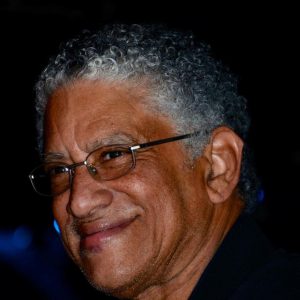
Live At Club 39 album cover
Amadee Castenell has been a storied musician in New England for many years now. Many area players have invited the flutist-saxophonist to play on their CDs. Many have invited him to play at their jams and to sit in at their shows. Castenell’s Live At Club 39 is not a recording of a show but a recording of Castenell and friends playing live at Club 39 Recording Studio in Sudbury, Massachusetts. Some of these tracks were cut in just one take and their freshness makes them feel like they’re jumping right of the stereo speakers.
This kind of instrumental music just can’t be beat. There is so much going on in each track that is impossible to not get caught up in Castenell’s arrangements and originals. Opening cut “Blues For Dee” is a breezy, jazzy affair composed by Castenell himself. His sax line is like a warm, friendly puff of motion, a twisting, zig zagging line that crisscrosses with the rhythm section to create a whirlwind of emotion. The horn man keeps his number lively, hopping, and invigorating as support players keep things in motion beneath his melodic line.
Castenell’s take on Donny Hathaway’s “Valdez In The Country” finds his flute playing in fine form. His melodic line glides like a graceful bird in flight, sailing around his backing musicians who are busy themselves, providing peppy Latin percussion, jazzy electric piano, and a smooth grooving rhythm section. Guitarist Kevin Belz unleashes his own jazzy joyride, a lightly touched melody that flirts with the rhythm section as well as providing a counterpoint to Castenell’s dancing flute notes.
Castenell and his team have fun with Henry Mancini’s “The Pink Panther Theme.” The sly groove that commences this piece gives Castenell plenty of room to strut his stuff. He takes on the popular line with a feel for the groove beneath him. Then, things get even more interesting when all the players take matters into their own hands. Bopping electric piano spices up the vibe with its sophisticated tinkling. Castenell jams on the main melodic line, taking us on twists and turns the further he explores the possible directions he can take this tune.
Castenell’s “Buda” is a more up-tempo number with a jazzy flair. His saxophone contrasts well with a flinty, flowing Kevin Belz lead guitar phrase. The horn line bounces along, brassy, lively, as if it’s floating on air. The lead guitar phrase is a sharp, jazzy expression, one that can freely move in any direction, loose, alive, and going whichever way it chooses.
“Dindi” is a dreamy weave of sax, keys, and percussion. Castenell’s horn line blows mellifluously, easefully, down tempo over a bright, light touch of electric keys and some fancy percussion work, just enough rhythm from Maureen Medeiros. This is a tune to enjoy with a quiet drink after a long day. It finesses its way into the listener’s consciousness by offering a lot in a low key manner.
“Funk Thing,” an original by Castenell and his colleagues Parker Wheeler, Steve Bankuti, Steve Monahan, Tom West, and K. Bell winds up with a bristling lead guitar phrase and a simmering organ line. From there, it pitches forward like a true party. The listener can picture people dancing and socializing at a large, lively event. The percussion keeps up a persistent chug. A harmonica line from Parker Wheeler is tightly wrapped around the horn, making one appreciate its jubilant melody even more. Each instrument here is like an individual personality adding something to the party.
Castenell returns to his magic flute on a cover of Herb Albert’s “Green Lemonade.” Here, he plays a breezy, light, but beautifully melodic line that sweetly tap dances around a mild groove. This tune makes it mark by whistling as prettily as it can while riding its bottom motions. Its quaint, subtle motions become more interesting and intriguing as the tune progresses.
Allan Toussaint‘s piece “I Wouldn’t Mind” receives an interesting interpretation. Castenell’s rendition layers saxophone and lead guitar into a jazzy mix and peppers both with adept percussion work. Castenell’s upward, widening swoops of melody color this affair perfectly and a slapping groove from drums, percussion, and keys keep it a toe tapping fun number.
The catchy, familiar Herbie Mann classic “Memphis Underground” goes wafting across the soundscape with many jazz and R&B flavors coloring it finely. Castenell’s flute rides the melody line with a fine sensitivity, following the groove while remaining suspended over it. His darting notes that move so well it’s impossible not to follow along with each.
Castenell and company close out with their arrangement of Louis Armstrong’s “Wonderful World.” Elegant piano notes from Ernest Eckois lay out a fine background for Castenell’s delicate, tender sax phrasing. His every note is dripping with richness and his line takes sudden snappy twists that keep it in engaging. Castenell soon switches to alto sax and lays out something even richer but just as lolling.
It’s uncanny how well Amadee Castenell can turn a melodic phrase. He asserts himself with ease, clarity, and mastery on either tenor sax, alto sax, or flute during any of his own compositions. He also makes his own several timeless gems by great artists of the past and present. After just one listen to his Live At Club 39 album, one understands how Castenell’s legend has grown and why everyone wants to invite him into the studio and onto the live stage. He’s that good.
https://www.facebook.com/amadee.castenell/about?lst=100003270056778%3A100022955507075%3A1513189452

